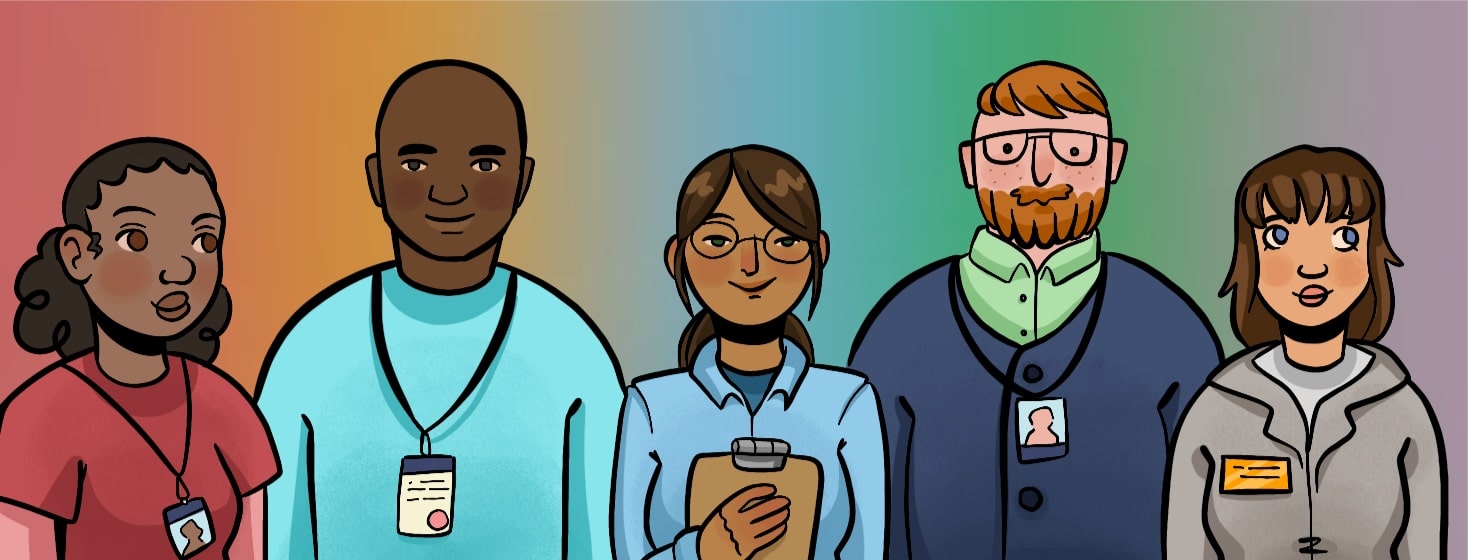Who’s Who in the Sleep Clinic?
If you’re going to participate in a sleep study, you may encounter more than one person working at a clinic, and several of those people may not be your sleep physician.
Here’s a quick overview of the different healthcare workers you’ll likely meet and interact with as part of your sleep study.
Who works at a sleep clinic?
Credential alphabet soup
Aside from the sleep doctor, who may hold several different credentials, other allied medical professionals also serve critical roles at the sleep clinic. It's not a bad idea to know who does what. So, if you have concerns or questions, you can reach out to the right person.
Here’s a breakdown of their credentials.
- RST: Registered Sleep Technician
- RPSGT: Registered Polysomnographic Technologist
- CRT: Certified Respiratory Therapist
- RRT: Registered Respiratory Therapist
- CCSH: Certified Clinical Sleep Health educator
The RST and CRT describe entry-level credentials, while those undergoing more extensive training are granted RPSGT and RRT credentials.
Meanwhile, the newer CCSH credential focuses on a broad array of sleep medicine aspects that move beyond testing and therapy. These workers earn their credentials first through intense training programs, then by sitting for rigorous board exams.
Credentials renew every five years based on adequate continuing education completed outside the job.
Are there nurses at sleep labs?
RSTs, RPSGTs, CRTs, RRTs and CCSHs are not nurses.
- They possess no legal capacity to dispense medication (not even over-the-counter drugs like aspirin or antacids)
- They are given zero basic nursing training (such as toileting or bathing patients)
For patients who use home health care services with a nursing component, their caregivers are expected to join them for the study to assist in any of these nursing activities. They also usually stay the night in the room adjacent.
It’s worth noting that nurses may and often do go on to earn one or more of these additional sleep medicine credentials, allowing them to specialize and fill some of these roles in the sleep lab.
A sleep clinic hierarchy
By and large, most sleep clinics organize their staff in this fashion.
Sleep physician
The sleep physician is a fully credentialed doctor (often a pulmonologist or neurologist) who has earned additional credentials in sleep medicine. They order sleep studies, review test results, issue diagnoses, and recommend treatment.
Patients first consult with them, then revisit them to review test results.
Sleep technician or technologist (RST, RPSGT)
This person runs nighttime (or daytime) sleep studies. They apply the sensors that connect patient biological signals to sophisticated lab equipment. They also help with requests during your study, such as assistance to and from the bathroom at night.
Respiratory therapist (CRT, RRT)
Respiratory therapists who run sleep studies have also studied for and earned additional credentials in sleep technology in order to perform these tests.
Scoring technician (RST, RPGST, CRT, RRT, CCSH)
Sleep studies gather a comprehensive array of data that needs to be coded in such a way that the sleep physician can accurately interpret their results.
A scoring technician works on-site or remotely to code several hours of data; often, the nighttime laboratory worker who runs the study may complete some of the scoring as it occurs as well.
All of these notes, together, give the sleep doctor the best snapshot of that patient’s sleep in a report. This report helps them determine any eventual diagnosis.
PAP educator (RST, RPSGT, CRT, RRT, CCSH)
Many patients need additional coaching following diagnosis, especially with using PAP (positive airway pressure) therapy.
A PAP educator typically meets with patients during the day to teach them how to use their equipment and avoid common usage problems.
Sleep health educator (RST, RPSGT, CRT, RRT, CCSH)
Sometimes patients need help that’s unrelated to PAP use. Some doctors employ a professional sleep health educator who can assist you, especially with problems connected to sleep hygiene.
Hospitals also sometimes use sleep health educators to screen newly admitted patients with chronic health problems for possible sleep disorders.
DME provider or supplier (RST, RPSGT, CRT, RRT, CCSH)
DME stands for durable medical equipment. Most DME providers in the sleep field deliver PAP therapy devices and oxygen delivery systems to newly diagnosed patients who need assistance with breathing during sleep.
These providers may be located inside or outside the clinic and, like PAP educators or sleep health educators, provide education and support for patients both at the beginning of therapy and afterward, as needs and technologies change.
Scheduler or medical assistant
A sleep clinic’s “front of the office” usually consists of a small group of administrative employees and medical assistants whose jobs entail:
- Setting up appointments and patient records
- Communicating patient information to other professionals in the clinic
- Sending patients important documentation for completion before their studies
- Handling insurance claims and pre-authorizations
- Making calls after studies to follow up
What staff have you met at the sleep clinic? Do you have any questions? Share your experience in the comment section.

Join the conversation